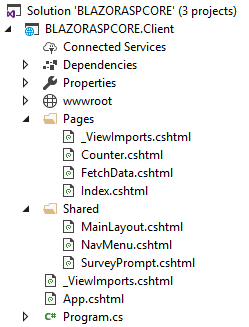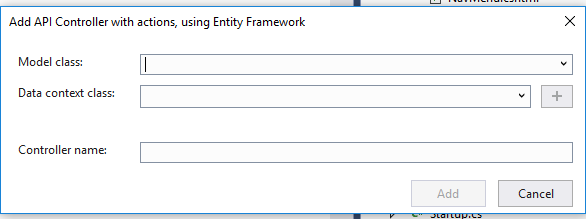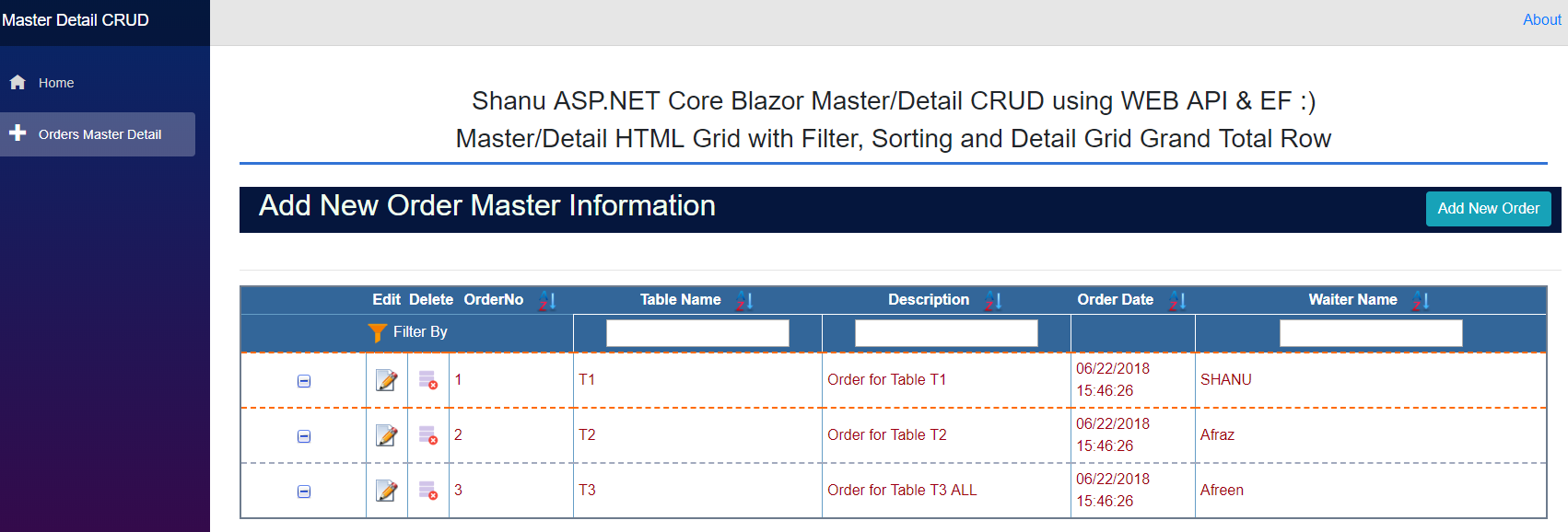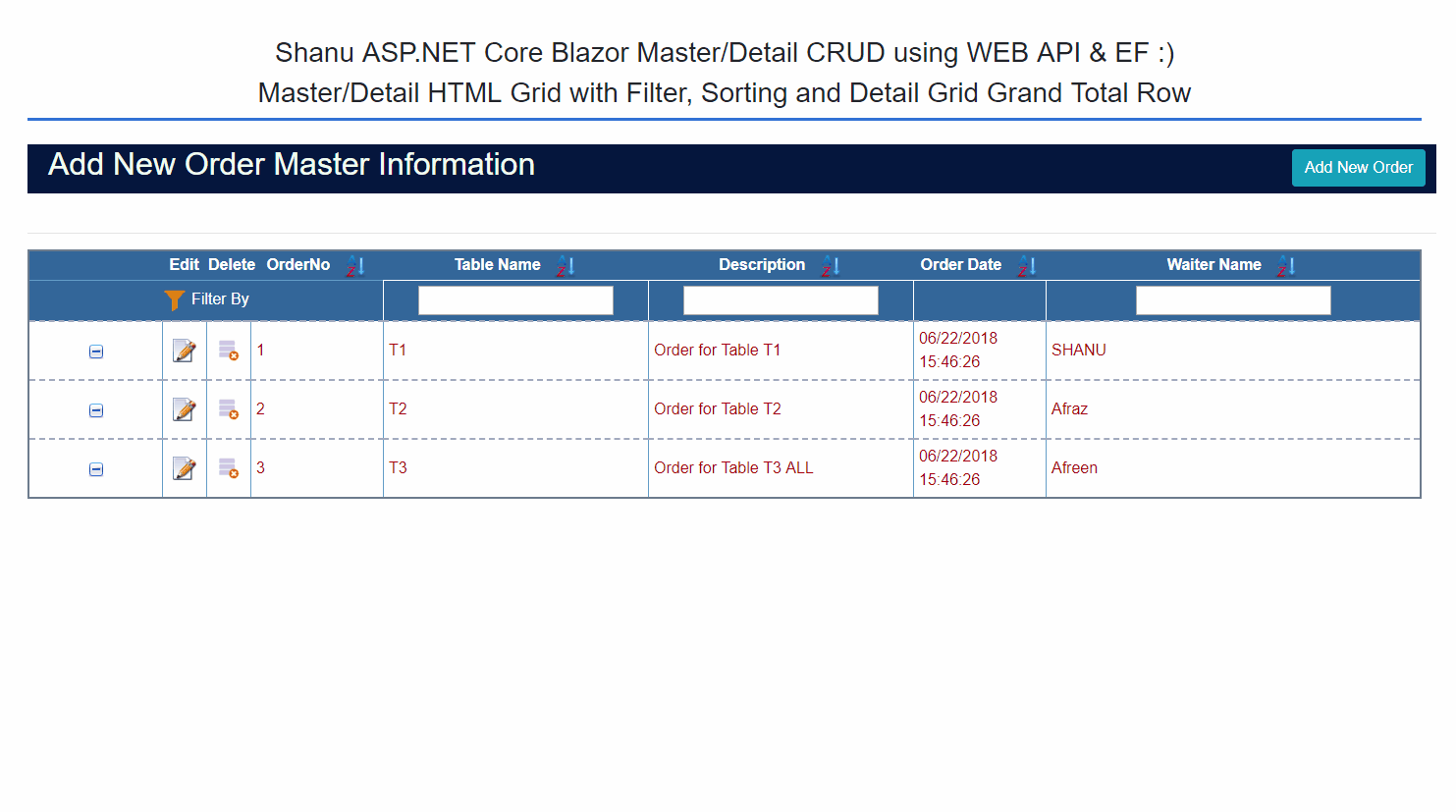ASP.NET Core Blazor Master/Detail CRUD with Filtering and Sorting using EF and Web API
Introduction
In this article, let’s see how to create our own ASP.NET Core Blazor Master Detail HTML CRUD (Insert, Update, Select and Delete) for both Master and Detail Grid with Sorting and Filtering using Entity Framework, and Web API.
This article will explain on: ** **
- How to Create Order Master and Order Detail table with sample records inserted.
- How to create a ASP.NET Core Blazor Web application.
- How to install the Package for using Entity Framework and creating DBContext class.
- Create a separate WEB API for both Order Master and Order Detail
- How to get the result from Web API and bind it in a Blazor client Razor view to display our Master/Detail HTML grid.
- Add Sorting /Filtering features for Master HTML grid.
- Add/Edit/ and Delete each Order Master and Order Detail from grid.
Prerequisites
Make sure, you have installed all the prerequisites in your computer. If not, then download and install all, one by one. Note that since Blazor is the new framework and we must have installed the preview of Visual Studio 2017 (15.7) or above.
- Install the .NET Core 2.1 Preview 2 SDK. (You can find all versions from this link
- Install the latest preview of Visual Studio 2017 (15.7).
- Install the ASP.NET Core Blazor Language Services for Blazor Extentions.
Code part
Step 1 - Create a database and a table
We will create an Order Master and Order Detail table to be used for the Master and Detail Grid data binding. The following is the script to create a database, table and sample insert query. Run this script in your SQL Server
use master
--create DataBase
-- 1) Check for the Database Exists .If the database is exist then drop and create new DB
IF EXISTS (SELECT [name] FROM sys.databases WHERE [name] = 'OrderManagement' )
DROP DATABASE OrderManagement
GO
CREATE DATABASE OrderManagement
GO
USE OrderManagement
GO
-- Create OrderMasters Table
CREATE TABLE [dbo].[OrderMasters](
[Order_No] INT IDENTITY PRIMARY KEY,
[Table_ID] [varchar](20) NOT NULL,
[Description] [varchar](200) NOT NULL,
[Order_DATE] [datetime] NOT NULL,
[Waiter_Name] [varchar](20) NOT NULL
)
-- Insert OrderMasters sample data
INSERT INTO [OrderMasters]
([Table_ID] ,[Description],[Order_DATE],[Waiter_Name])
VALUES
('T1','Order for Table T1',GETDATE(),'SHANU' )
INSERT INTO [OrderMasters]
([Table_ID] ,[Description],[Order_DATE],[Waiter_Name])
VALUES
('T2','Order for Table T2',GETDATE(),'Afraz' )
INSERT INTO [OrderMasters]
([Table_ID] ,[Description],[Order_DATE],[Waiter_Name])
VALUES
('T3','Order for Table T3',GETDATE(),'Afreen')
CREATE TABLE [dbo].[OrderDetails](
[Order_Detail_No] INT IDENTITY PRIMARY KEY,
[Order_No] INT,
[Item_Name] [varchar](20) NOT NULL,
[Notes] [varchar](200) NOT NULL,
[QTY] INT NOT NULL,
[Price] INT NOT NULL
)
--Now let’s insert the 3 items for the above Order No 'Ord_001'.
INSERT INTO [OrderDetails]
( [Order_No],[Item_Name],[Notes],[QTY] ,[Price])
VALUES
(1,'Ice Cream','Need very Cold',2 ,160)
INSERT INTO [OrderDetails]
([Order_No],[Item_Name],[Notes],[QTY] ,[Price])
VALUES
(1,'Coffee','Hot and more Suger',1 ,80)
INSERT INTO [OrderDetails]
([Order_No],[Item_Name],[Notes],[QTY] ,[Price])
VALUES
(1,'Burger','Spicy',3 ,140)
INSERT INTO [OrderDetails]
([Order_No],[Item_Name],[Notes],[QTY] ,[Price])
VALUES
(2,'Pizza','More Chees and Large',1 ,350)
INSERT INTO [OrderDetails]
([Order_No],[Item_Name],[Notes],[QTY] ,[Price])
VALUES
(2,'Cola','Need very Cold',3 ,50)
INSERT INTO [OrderDetails]
([Order_No],[Item_Name],[Notes],[QTY] ,[Price])
VALUES
(3,'IDLY','Hot',3 ,40)
INSERT INTO [OrderDetails]
([Order_No],[Item_Name],[Notes],[QTY] ,[Price])
VALUES
(3,'Thosa','Hot',3 ,50)
-- To Select and test Order Master and Details
Select * FROM OrderMasters
Select * From OrderDetails
Step 2 - Create ASP.NET Core Blazor Application
After installing all the prerequisites listed above and ASP.NET Core Blazor Language Services, click Start >> Programs >> Visual Studio 2017 >> Visual Studio 2017 on your desktop. Click New >> Project. Select Web >> ASP.NET Core Angular Web Application. Enter your project name and click OK.
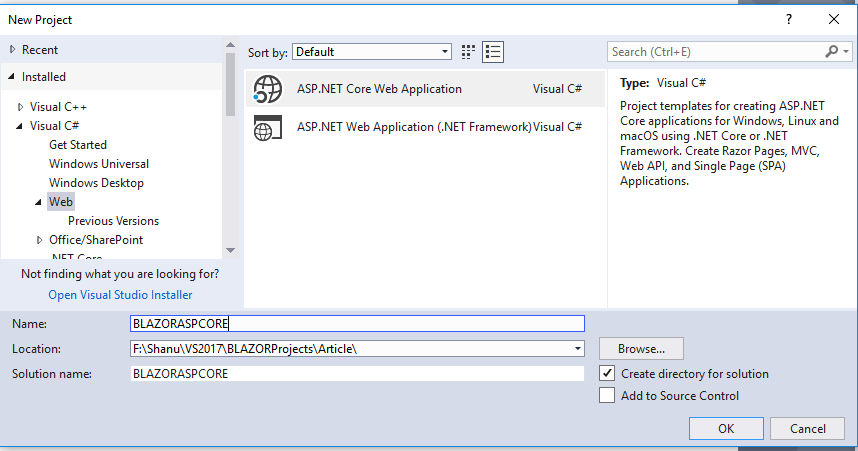
Select Blazor (ASP.NET Core hosted) and click ok
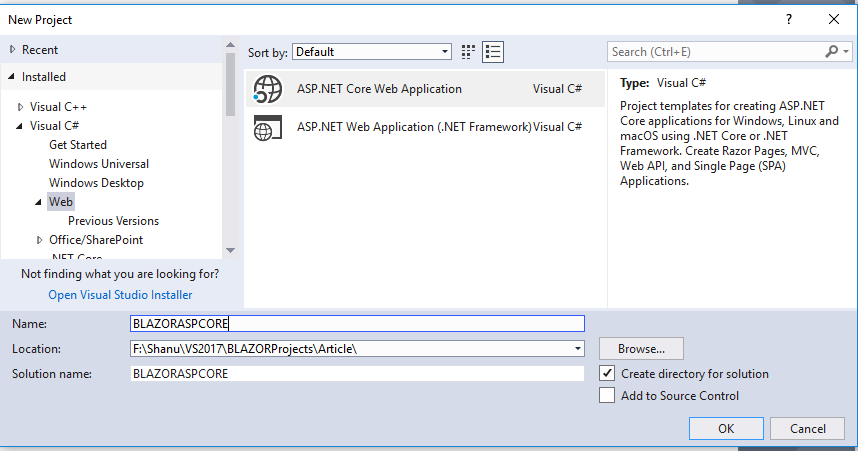
After creating ASP.NET Core Blazor Application, wait for few seconds. You will see below structure in solution explorer.
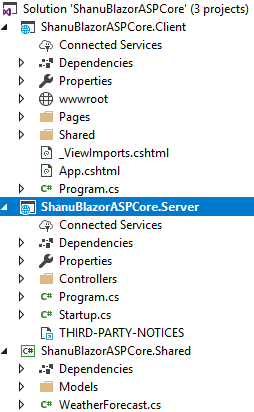
What is new in ASP.NET Core Blazor solution?
When we create our new ASP.NET Core Blazor application we can see as there will be 3 projects will be automatically created in the Solution Explorer.
Client Project
The first project created as the Client project and it will be as our Solutionname.Client and here we can see as our Solutionname as “BlazorASPCORE". As the project named as a client and this project will be mainly focused for all the client-side view. Here we will be adding all our page view to be displayed in the client side in a browser.
We can see that a few sample page have been already added here and we can also see a shared folder same like our MVC application where will be having the Sharedfolder and Layout page for the Master page. Here in Blazor we have the MainLayout which will be work like the Master page and NavMenu for the left side menu display.
Server Project
As the name indicating this project will be used as a Server project. This project is mainly used to create all our Controllers and WEB API Controllers to perform all business logic and perform CRUD operation using WEB API’s. In our demo application, we will be adding a Web API in this Server project and all the WEB API in our Client application. This Server project will be work like get/set the data from Database and from our Client project we bind or send the result to this server to perform the CRUD.
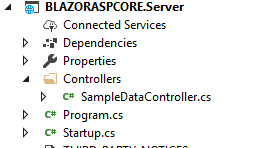
Shared Project
As the name indicating this project work like a shred project. This project works as a Model for our Server project and for the Client project. The Model declared in this Shared project will be used in both the Server and in the Client project. We also install all the packages needed for our project here, for example, to use the Entity Framework we install all the packages in this Shared project.

Run to test the application
When we run the application, we can see that the left side has navigation and the right side contains the data. We can see as the default sample pages and menus will be displayed in our Blazor web site. We can use the pages or remove it and start with our own page.

Now let’s see how to add new page perform the CRUD operation for maintaining Order details.
Using Entity Framework
To use the Entity Framework in our Blazor application we need to install the below packages
Install the Packages
Go to Tools and then select -> NuGet Package Manager -> Package Manager Console.
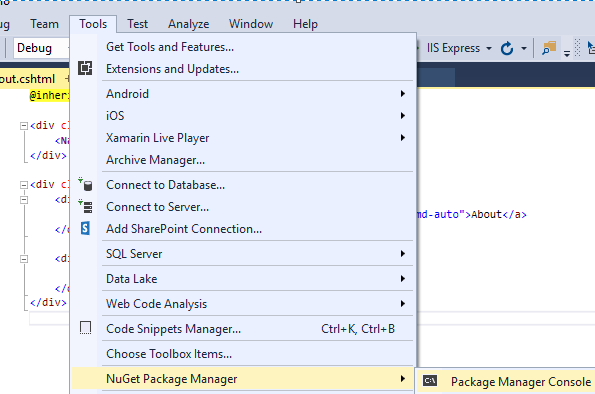
You can see the Console at the bottom of the VS 2017 IDE and in the right side of the combobox on the console select the Default project as your shared project” Select Shared”

1) You can see the PM> and copy and paste the below line to install the Database Provider package. This package is used to set the database provider as SQL Server
Install-Package Microsoft.EntityFrameworkCore.SqlServer
We can see as the package is installed in our Shared folder
Install the Entity Framework
2) You can see the PM> and copy and paste the below line to install the EF package.
Install-Package Microsoft.EntityFrameworkCore.Tools
To Create DB Context and set the DB Connection string
3) You can see the PM> and copy and paste the below line set the Connection string and create DB Context. This is an important part as we give our SQL Server name, Database Name and SQL server UID and SQL Server Password to connect to our database for performing the CRUD operation. We also give our SQL Table name to create the Model class in our Shared project.
Scaffold-DbContext "Server= SQLServerName;Database=OrderManagement;user id=SQLID;password=;Trusted_Connection=True;MultipleActiveResultSets=true" Microsoft.EntityFrameworkCore.SqlServer -OutputDir Models -Tables OrderMasters ,OrderDetails
Press enter create connection string, Model Class and Database Context.
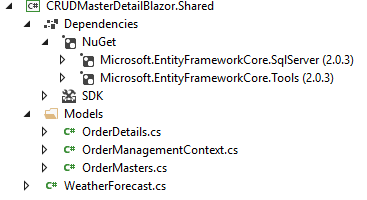
We can see OrderMasters Model class and OrderManagementContext class has been created in our Shared project. We will be using this Model and DBContext in our Server project to create our Web API to perform the CRUD operations. ** **
Creating Web API for CRUD operation
To create our WEB API Controller, right-click Controllers folder. Click Add New Controller.
Here we will be using Scaffold method to create our WEB API. We select API Controller with actions, using Entity Framework.
Select our Model and DatabaseContext from the Shared project.
Select our OrderMasters Model from the Shared Project for performing the CRUD operation.
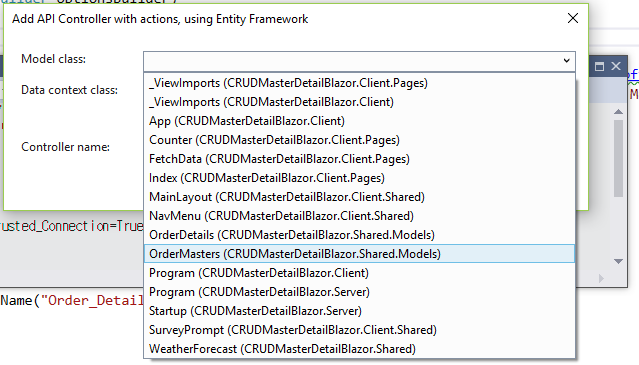
Select the Data Context Class as our OrderManagementContext from the Shared project. Our Controller name will be automatically added if you need you can change it and click the ADD.
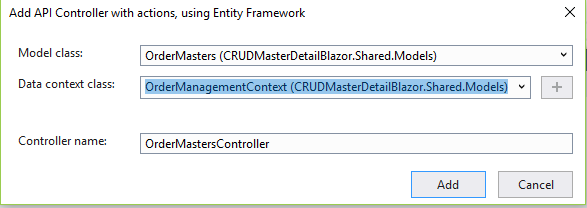
We will be using only the Get method from our Web API.
Same like this we also create a Web API for our OrderDetails.
To test Get Method, we can run our project and copy the GET method API path. Here, we can see our API path to get api/OrderMasters/
Run the program and paste API path to test our output.
For OrderDetails we can pass the Order ID to get only Orderdetails. Here we can see the result for Order ID as “1” we call the Web API as /api/OrderDetails/1
Now we will bind all this WEB API Json result in our Razor View page from our Client project for display the Master/Detail HTML table.
Working with Client Project
First, we need to add the new Razor view page
Add Razor View
To add the Razor view page right click the Pages folder from the Client project. Click on Add >> New Item

Select Razor View >> Enter your page name,Here we have given the name as Orders.chtml

In Razor view Page we have 3 parts of code as first is the Import part where we import all the references and models for using in the view, HTML design and data bind part and finally we have the function part to call all the web API to bind in our HTML page and also to perform client-side business logic to be displayed in View page.
Import part
First, we import all the needed support files and references in our Razor View page. Here we have first imported our Model class to be used in our view and also imported HTTPClient for calling the Web API to perform the CRUD operations.
@using BLAZORASPCORE.Shared
@using BLAZORASPCORE.Shared.Models
@page "/Orders"
@using Microsoft.AspNetCore.Blazor.Browser.Interop
@inject HttpClient Http
Master HTML Grid data Bind part
Next, we design our Order page to bind the Order Master and Order Detail results from the Web API to HTML table.
Binding Order Master Details:
In the Init Method we get the Order Master from Web API and bind the result in HTML table using foreach loop. Here we bind the result for Order Master Grid and in each row first column we add the Toggle image and, in this Toggle, image click event we call the getOrderDetails(OrderNo) method to display the Detail HTML grid for the related Order. We pass the Order No to the function and we get the related Order details for the Order and bind the result in detail grid also we will show the detail grid only when the toggle image button is clicked and if the toggle button clicked again we hide the detail grid. We also have Edit and Delete buttons to edit and delete the Order Master record from the database.
@foreach (var OrderMasterobj in ordMaster)
{
<tr style="border-style:dashed;border-width:2px;border-color: @(OrderMasterobj.OrderNo == orderIDs ? "#ff6a00": "#a2aabe")">
<td align="center" style="border: solid 1px #659EC7; padding: 5px;table-layout:fixed;">
@if (@OrderMasterobj.OrderNo == orderIDs)
{
<img src="@Imagename" onclick="@(async () => await getOrderDetails(@OrderMasterobj.OrderNo))" />
}
else
{
<img src="Images/toggle.png" onclick="@(async () => await getOrderDetails(@OrderMasterobj.OrderNo))" />
}
</td>
<td align="center" style="border: solid 1px #659EC7; padding: 5px;table-layout:fixed;">
<span style="color:#9F000F">
<img src="Images/edit.gif" alt="Edit" width="24px" height="24px" onclick="@(async () => await EditOrderMaster(@OrderMasterobj.OrderNo))" />
</span>
</td>
<td align="center" style="border: solid 1px #659EC7; padding: 5px;table-layout:fixed;">
<span style="color:#9F000F">
<img src="Images/delete.gif" alt="Delete" width="24px" height="24px" onclick="@(async () => await DeleteOrderMaster(@OrderMasterobj.OrderNo))" />
</span>
</td>
<td align="left" style="border: solid 1px #659EC7; padding: 5px;table-layout:fixed;">
<span style="color:#9F000F">
@OrderMasterobj.OrderNo
</span>
</td>
<td align="left" style="border: solid 1px #659EC7; padding: 5px;table-layout:fixed;">
<span style="color:#9F000F">
@OrderMasterobj.TableId
</span>
</td>
<td align="left" style="border: solid 1px #659EC7; padding: 5px;table-layout:fixed;">
<span style="color:#9F000F">
@OrderMasterobj.Description
</span>
</td>
<td align="left" style="border: solid 1px #659EC7; padding: 5px;table-layout:fixed;">
<span style="color:#9F000F">
@OrderMasterobj.OrderDate
</span>
</td>
<td align="left" style="border: solid 1px #659EC7; padding: 5px;table-layout:fixed;">
<span style="color:#9F000F">
@OrderMasterobj.WaiterName
</span>
</td>
</tr>
Function Part
Function part to call all the web API to bind in our HTML page and also to perform client-side business logic to be displayed in View page.
In the Init method we get the result of Web API for Order Master and store it in the ordMaster object and we using this object to be bind in our html table using the foreach statement.
@functions {
OrderMasters[] ordMaster;
OrderDetails[] ordDetail;
OrderMasters ordsM = new OrderMasters();
OrderDetails ordsD = new OrderDetails();
Boolean showAddMaster = false;
Boolean showAddDetail = false;
int showDetailStatus = 0;
int sortStatus = 0;
int orderIDs = 0;
string Imagename = "Images/toggle.png";
string ImageSortname = "Images/sortAsc.png";
string Messages = "";
protected override async Task OnInitAsync()
{
ordMaster = await Http.GetJsonAsync<OrderMasters[]>("/api/OrderMasters/");
ordsD = new OrderDetails();
ordsM = new OrderMasters();
Messages = "";
}
Adding Sorting features in Table Heading
Here we have added the Sorting and Filtering features only for the Master HTML table. If needed then we can implement this same feather for Detail grid as well.
In the Master Table heading part for each heading, we add the Sorting Image. In Sorting Image Button Click event we call the Sorting function and pass each Sorting Column name to the click event. In Function code part we sort the Web API and display the result by ascending and in descending order by each column header soring image click.
<table style=" background-color:#FFFFFF; border: solid 2px #6D7B8D; padding: 5px;width: 99%;table-layout:fixed;" cellpadding="2" cellspacing="2">
<tr style="height: 30px; background-color:#336699 ; color:#FFFFFF ;border: solid 1px #659EC7;">
<td width="120"></td>
<td width="40" align="center"><b>Edit</b></td>
<td width="40" align="center"><b>Delete</b></td>
<td width="120" align="center" style="cursor: pointer;">
<b>OrderNo</b>
<img src="@ImageSortname" onclick="@(async () => await OrderMasterSorting("OrderNo"))" height="24" width="24" />
</td>
<td width="240" align="center" style="cursor: pointer;">
<b>Table Name</b>
<img src="@ImageSortname" onclick="@(async () => await OrderMasterSorting("TableId"))" height="24" width="24" />
</td>
<td width="240" align="center" style="cursor: pointer;">
<b>Description</b>
<img src="@ImageSortname" onclick="@(async () => await OrderMasterSorting("Description"))" height="24" width="24" />
</td>
<td width="120" align="center" style="cursor: pointer;">
<b> Order Date</b>
<img src="@ImageSortname" onclick="@(async () => await OrderMasterSorting("OrderDate"))" height="24" width="24" />
</td>
<td width="340" align="center" style="cursor: pointer;">
<b> Waiter Name</b>
<img src="@ImageSortname" onclick="@(async () => await OrderMasterSorting("WaiterName"))" height="24" width="24" />
</td>
</tr>
Sorting Method
In Sorting image click on each column heading we call this method and pass the column name to this method. In this method depend on column name we do Sorting the Web API result and bind the result in the HTML table. We also do the vise versa sorting of Ascending and descending.
//Order Master
protected async Task OrderMasterSorting(string SortColumn)
{
ordMaster = await Http.GetJsonAsync<OrderMasters[]>("/api/OrderMasters/");
Messages = "";
if (sortStatus == 1)
{
ImageSortname = "Images/sortDec.png";
sortStatus = 0;
switch (SortColumn)
{case"OrderNo":
ordMaster = ordMaster.OrderBy(x => x.OrderNo).ToArray();
break;
case"TableId":
ordMaster = ordMaster.OrderBy(x => x.TableId).ToArray();
break;
case"Description":
ordMaster = ordMaster.OrderBy(x => x.Description).ToArray();
break;
case"OrderDate":
ordMaster = ordMaster.OrderBy(x => x.OrderDate).ToArray();
break;
case"WaiterName":
ordMaster = ordMaster.OrderBy(x => x.WaiterName).ToArray();
break;
}}else{
ImageSortname = "Images/sortAsc.png";
sortStatus = 1;
switch (SortColumn)
{case"OrderNo":
ordMaster = ordMaster.OrderByDescending(x => x.OrderNo).ToArray();
break;
case"TableId":
ordMaster = ordMaster.OrderByDescending(x => x.TableId).ToArray();
break;
case"Description":
ordMaster = ordMaster.OrderByDescending(x => x.Description).ToArray();
break;
case"OrderDate":
ordMaster = ordMaster.OrderByDescending(x => x.OrderDate).ToArray();
break;
case"WaiterName":
ordMaster = ordMaster.OrderByDescending(x => x.WaiterName).ToArray();
break;
}}}
Adding Filtering features in Table Heading
In the table heading part, we add a new row. In table row, we add the Textbox for each column to perform the filtering for the bound result. In Textbox onChange event we call the method to perform the Filtering operation from the code function part,
// For Filtering by OrderNovoid OnOrderNoChanged(UIChangeEventArgs args)
{
string values = args.Value.ToString();
OrderMasterFilteringList(values, "OrderNo");
}// For Filtering by TableIdvoid OnTableIdChanged(UIChangeEventArgs args)
{
string values = args.Value.ToString();
OrderMasterFilteringList(values, "TableId");
}// For Filtering by Descriptionvoid OnDescriptionChanged(UIChangeEventArgs args)
{
string values = args.Value.ToString();
OrderMasterFilteringList(values, "Description");
}// For Filtering by OrderDatevoid OnOrderDateChanged(UIChangeEventArgs args)
{
string values = args.Value.ToString();
OrderMasterFilteringList(values, "OrderDate");
}// For Filtering by WaiterNamevoid OnWaiterNameChanged(UIChangeEventArgs args)
{
string values = args.Value.ToString();
OrderMasterFilteringList(values, "WaiterName");
}
Filtering Method
In each column heading part, we have added a new row for performing the Filtering of the HTML grid. In each column filter Textbox Change event, we pass the Textbox value. We call a common filtering method OrderMasterFilteringList and in this method, we pass the filtering column Textbox value and column Name.
// For Filtering by OrderNovoid OnOrderNoChanged(UIChangeEventArgs args)
{
string values = args.Value.ToString();
OrderMasterFilteringList(values, "OrderNo");
}// For Filtering by TableIdvoid OnTableIdChanged(UIChangeEventArgs args)
{
string values = args.Value.ToString();
OrderMasterFilteringList(values, "TableId");
}// For Filtering by Descriptionvoid OnDescriptionChanged(UIChangeEventArgs args)
{
string values = args.Value.ToString();
OrderMasterFilteringList(values, "Description");
}// For Filtering by OrderDatevoid OnOrderDateChanged(UIChangeEventArgs args)
{
string values = args.Value.ToString();
OrderMasterFilteringList(values, "OrderDate");
}// For Filtering by WaiterNamevoid OnWaiterNameChanged(UIChangeEventArgs args)
{
string values = args.Value.ToString();
OrderMasterFilteringList(values, "WaiterName");
}
Here we create a common function named as OrderMasterFilteringList and in this method, we get the filtering column Textbox value and column Name. We do filtering from the Web API and bind the filtering result to the HTML Table.
//Filtering
protected async Task OrderMasterFilteringList(String Value, string columnName)
{
ordMaster = await Http.GetJsonAsync<OrderMasters[]>("/api/OrderMasters/");
Messages = "";
if (Value.Trim().Length > 0)
{switch (columnName)
{case"TableId":
ordMaster = ordMaster.Where(x => x.TableId.Contains(Value)).ToArray();
break;
case"Description":
ordMaster = ordMaster.Where(x => x.Description.Contains(Value)).ToArray();
break;
case"WaiterName":
ordMaster = ordMaster.Where(x => x.WaiterName.Contains(Value)).ToArray();
break;
}}else{
ordMaster = await Http.GetJsonAsync<OrderMasters[]>("/api/OrderMasters/");
}}
Insert new Order Master
In the ADD New Order Master button click, we will make visible the New Order Master Add table, where the user can enter the new Order information.
<table width="100%" style="background:#05163D;color:honeydew">
<tr>
<td width="20"> </td>
<td>
<h2> Add New Order Master Information</h2>
</td>
<td> </td>
<td align="right">
<button class="btn btn-info" onclick="@AddNewOrderMasters">Add New Order</button>
</td>
<td width="10"> </td>
</tr>
<tr>
<td colspan="2"></td>
</tr>
</table>
When Add New Order button is clicked we shoe the Add/Edit Order Master, here the user can update or add new Order Master.
@if (showAddMaster == true)
{
<table style=" background-color:#FFFFFF; border: dashed 3px #6D7B8D; padding: 5px;width: 99%;table-layout:fixed;" cellpadding="2" cellspacing="2">
<tr style="height: 30px; background-color:#336699 ; color:#FFFFFF ;border: solid 1px #659EC7;">
<td>
<h3> Add/Edit Order Master</h3>
</td>
</tr>
<tr>
<td>
<table class="form-group">
<tr>
<td>
<label for="Name" class="control-label">Order No</label>
</td>
<td>
<input type="text" class="form-control" bind="@ordsM.OrderNo" readonly />
</td>
<td width="20"> </td>
<td>
<label for="Name" class="control-label">Table Name</label>
</td>
<td>
<input type="text" class="form-control" bind="@ordsM.TableId" />
</td>
</tr>
<tr>
<td>
<label for="Email" class="control-label">Description</label>
</td>
<td>
<input type="text" class="form-control" bind="@ordsM.Description" />
</td>
<td width="20"> </td>
<td>
<label for="Name" class="control-label">Date</label>
</td>
<td>
<input type="text" class="form-control" bind="@ordsM.OrderDate" />
</td>
</tr>
<tr>
<td>
<label for="Name" class="control-label">Waiter Name</label>
</td>
<td>
<input type="text" class="form-control" bind="@ordsM.WaiterName" />
</td>
<td width="20"> </td>
<td></td>
<td>
<button type="submit" class="btn btn-success" onclick="@(async () => await SaveOrderMasters())" style="width:220px;">Save</button>
</td>
</tr>
</table>
</td>
</tr>
</table>
Save Method
In the Save method, we will check for the OrderNo. If the OrderNo is “0” then it will insert the new Order Master. Here we will call the Insert Web API method and if the OrderNo is > 0 then it means to update the Order record.
/Save New or update Order Master
protected async Task SaveOrderDetails()
{
if (ordsD.OrderDetailNo == 0)
{
await Http.SendJsonAsync(HttpMethod.Post, "/api/OrderDetails/", ordsD);
}
else
{
await Http.SendJsonAsync(HttpMethod.Put, "/api/OrderDetails/" + ordsD.OrderDetailNo, ordsD);
}
ordDetail = await Http.GetJsonAsync<OrderDetails[]>("/api/OrderDetails/" + Convert.ToInt32(ordsD.OrderNo));
ordsD = new OrderDetails();
showAddDetail = false;
showAddMaster = false;
Messages = "Order Detail Saved to Databse !";
}
Update Order Master
The same as Insert we will display the update details for the user to edit the Order Master and save it. In the Edit method, we will get all the details for the row where the user clicks on the Edit Icon and sets all the results to the appropriate TextBox. In the Save button click, we will call the save method to save all the changes to the database like Insert.
//Edit Order Master
protected async Task EditOrderMaster(int OrderNos)
{
showAddMaster = true;
ordsM = await Http.GetJsonAsync<OrderMasters>("/api/OrderMasters/" + Convert.ToInt32(OrderNos));
}
Delete Order Master Details
In the Delete button click, we will delete the Order by passing the OrderNo to the delete method of the Web API to delete the record from the database.
//Delete Order Master
protected async Task DeleteOrderMaster(int OrderNos)
{
await Http.DeleteAsync("/api/OrderMasters/" + Convert.ToInt32(OrderNos));
ordMaster = await Http.GetJsonAsync<OrderMasters[]>("/api/OrderMasters/");
Messages = "Order Master Deleted from Database !";
}
Detail Grid
Bind the Detail Grid result
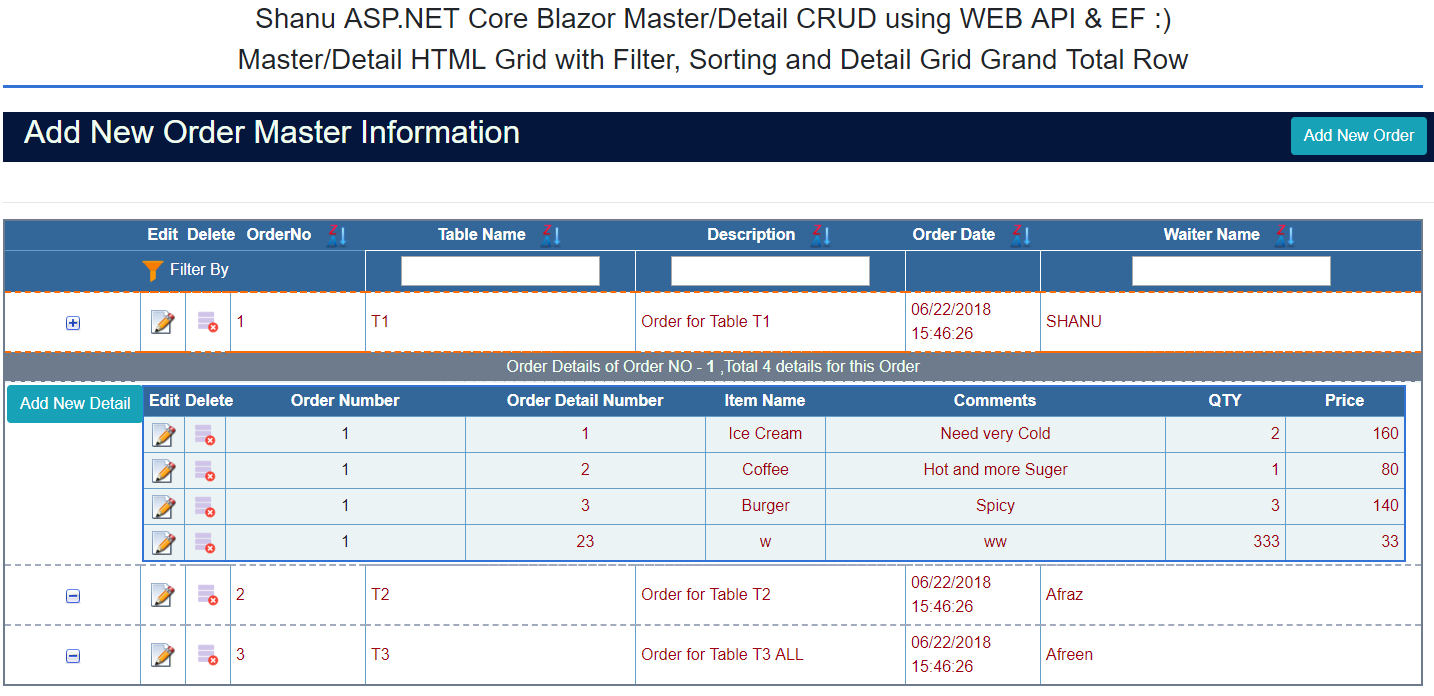
Firstly, we check the OrderDetail result is null, if it’s not null then we bind the result in HTML Table, before binding the result we also check for the showDetailStatus ==1 which means to show or hide the Detail Grid. By default, we set the showDetailStatus as 0 and in Master grid Toggle image click event we change the status to 1 and if the showDetailStatus is 1 then we display the Detail grid we also check the Master grid OrderNo with Order detail and bind the result in Detail Grid.** **
@if (ordDetail != null)
{
@if (showDetailStatus == 1)
{
@if (@OrderMasterobj.OrderNo == orderIDs)
{
<tr style="background-color:#6D7B8D ; color:honeydew ;border-style:dashed;border-width:2px;border-color:#ECF3F4;">
<td colspan="8" align="center">
Order Details of Order NO - <strong> @OrderMasterobj.OrderNo </strong> ,Total @ordDetail.Length details for this Order
</td>
</tr>
<tr>
<td valign="top">
<button class="btn btn-info" onclick="@(async () => await AddNewOrderDetails(@OrderMasterobj.OrderNo))">Add New Detail</button>
</td>
<td colspan="7">
<table style="background-color:#ECF3F4; border: solid 2px #3273d5; padding: 5px;width: 99%;table-layout:fixed;">
<tr style="height: 30px; background-color:#336699 ; color:#FFFFFF ;">
<td width="40" align="center"><b>Edit</b></td>
<td width="40" align="center"><b>Delete</b></td>
<td width="240" align="center">
<b> Order Number</b>
</td>
<td width="240" align="center">
<b> Order Detail Number</b>
</td>
<td width="120" align="center">
<b> Item Name</b>
</td>
<td width="340" align="center">
<b>Comments</b>
</td>
<td width="120" align="center">
<b> QTY</b>
</td>
<td width="120" align="center">
<b> Price</b>
</td>
</tr>
@foreach (var orderDetailsObj in ordDetail)
{
<tr>
<td align="center" style="border: solid 1px #659EC7; padding: 5px;table-layout:fixed;">
<span style="color:#9F000F">
<img src="Images/edit.gif" alt="Edit" width="24px" height="24px" onclick="@(async () => await EditOrderDetails(@orderDetailsObj.OrderDetailNo))" />
</span>
</td>
<td align="center" style="border: solid 1px #659EC7; padding: 5px;table-layout:fixed;">
<span style="color:#9F000F">
<img src="Images/delete.gif" alt="Delete" width="24px" height="24px" onclick="@(async () => await DeleteOrderDetails(@orderDetailsObj.OrderDetailNo))" />
</span>
</td>
<td align="center" style="border: solid 1px #659EC7; padding: 5px;table-layout:fixed;">
@orderDetailsObj.OrderNo
</td>
<td align="center" style="border: solid 1px #659EC7; padding: 5px;table-layout:fixed;">
<span style="color:#9F000F">
@orderDetailsObj.OrderDetailNo
</span>
</td>
<td align="center" style="border: solid 1px #659EC7; padding: 5px;table-layout:fixed;">
<span style="color:#9F000F">
@orderDetailsObj.ItemName
</span>
</td>
<td align="center" style="border: solid 1px #659EC7; padding: 5px;table-layout:fixed;">
<span style="color:#9F000F">
@orderDetailsObj.Notes
</span>
</td>
<td align="right" style="border: solid 1px #659EC7; padding: 5px;table-layout:fixed;">
<span style="color:#9F000F">
@orderDetailsObj.Qty
</span>
</td>
<td align="right" style="border: solid 1px #659EC7; padding: 5px;table-layout:fixed;">
<span style="color:#9F000F">
@orderDetailsObj.Price
</span>
</td>
</tr>
}
</table>
</td>
</tr>
}
}
}
Detail Grid bind, Hide/Show method
In the Master grid Toggle image click event we call this below method and pass the Order NO to get the appropriate Order details from the Web API and bind the result in the details HTML grid.
//--------------- Detail Grid CRUD
protected async Task getOrderDetails(int ordID)
{
showAddMaster = false;
showAddDetail = false;
Messages = "";
if (orderIDs != ordID)
{
Imagename = "Images/expand.png";
showDetailStatus = 1;
}else{if (showDetailStatus == 0)
{
Imagename = "Images/expand.png";
showDetailStatus = 1;
}else{
Imagename = "Images/toggle.png";
showDetailStatus = 0;
}}
orderIDs = ordID;
ordDetail = await Http.GetJsonAsync<OrderDetails[]>("/api/OrderDetails/" + Convert.ToInt32(ordID));
}
Order Detail Add/Edit and Delete
Same like the Order Master CRUD we also do Insert/Edit and Delete for the Order Details. Here from below gif image we can see the Detail grid bind, Insert, Update and Delete operations.
Navigation Menu
Now we need to add this newly added Orders Razor page to our left Navigation. For adding this Open the Shared Folder and open the NavMenu.cshtml page and add the menu.
<li class="nav-item px-3">
<NavLink class="nav-link" href="" Match=NavLinkMatch.All>
<span class="oi oi-home" aria-hidden="true"></span> Home
</NavLink>
</li>
<li class="nav-item px-3">
<NavLink class="nav-link" href="Orders">
<span class="oi oi-plus" aria-hidden="true"></span> Orders Master Detail
</NavLink>
</li>
Build and Run the APPlication
Conclusion
In this article we have added only one level of Hierarchy of grid, you can extend this to create multilevel Hierarchy of HTML grid. Note as when creating the DBContext and setting the connection string, don’t forget to add your SQL connection string. Hope you all like this article and in the next article we will see more examples to work with Blazor and it is really very cool and awesome to work with Blazor.
See Also
- ASP.NET Core Blazor CRUD using Entity Framework and Web API
- ASP.NET Core Blazor Filtering and Sorting using Entity Framework and Web API
- ASP.NET Core Blazor Master Detail Grid with Filtering and Sorting using EF and Web API
Download
ASP.NET Core Blazor Master/Detail CRUD with Filtering and Sorting using EF and WEB API

